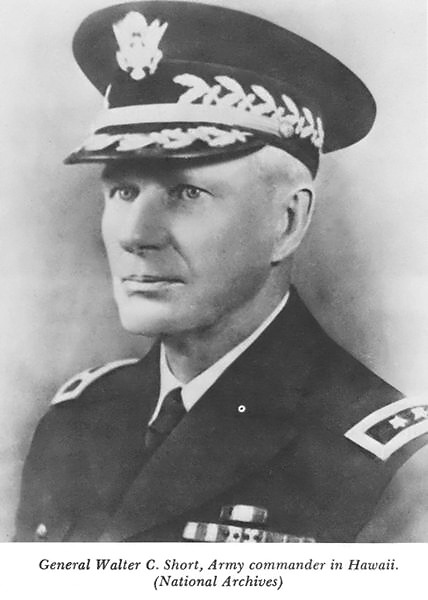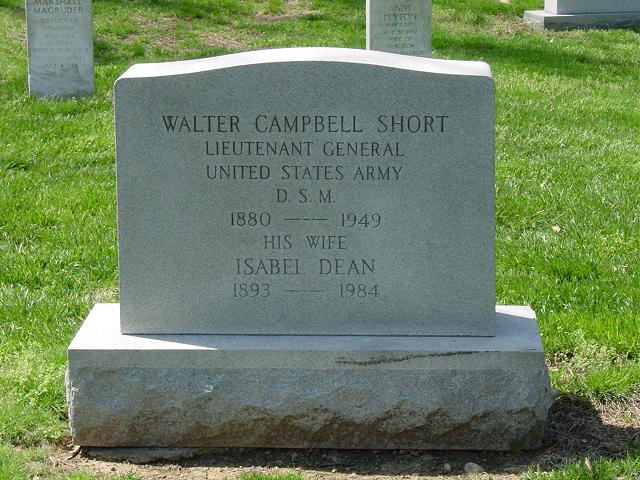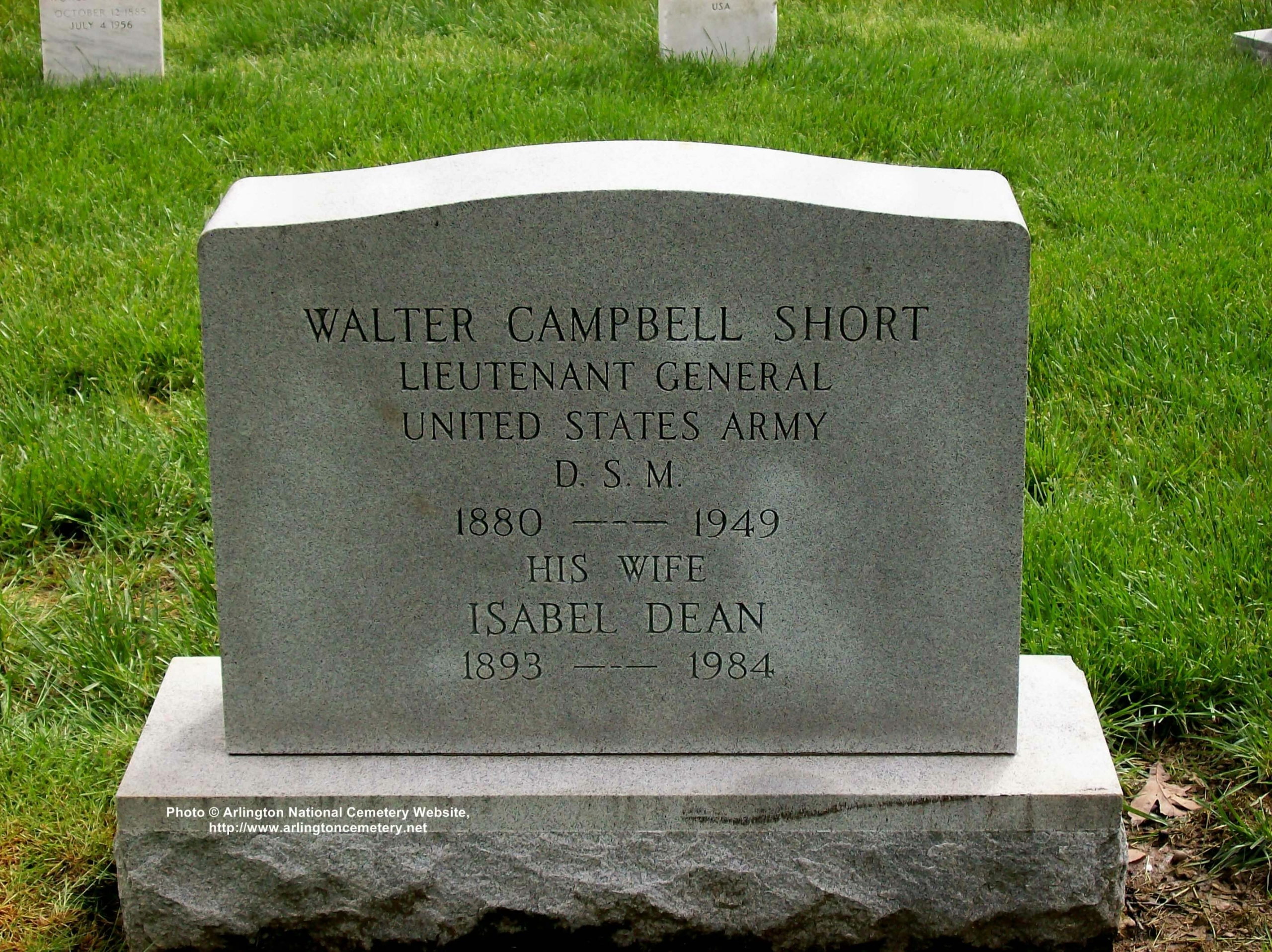Walter Short (1880-1949) commanded the Hawaiian Department of the United States Army when the Japanese launched a surprise attack at Pearl Harbor on December 7, 1941. The attack came as a complete surprise and inflicted perhaps the most decisive defeat ever suffered by U.S. forces. Short was held responsible and forced to retire from the military.
Walter Campbell Short was born in the rural Illinois town of Fillmore on March 30, 1880. As the son of a physician, he enjoyed a comfortable upbringing. Short attended the University of Illinois, graduating in 1901. He then obtained a position as teacher of mathematics at the Western Military Academy for one year before accepting a commission in the U.S. Army in March 1902.
Short’s progress through the military hierarchy was unremarkable but fairly impressive for a peacetime period. After a brief stint at the Presidio in San Francisco, California, he spent a five-year period with the 25th Infantry Division, based at Fort Reno, Oklahoma. During this time, Short became acquainted with George Marshall, who would later become Army chief of staff during World War II. Short was posted overseas to the U.S. territory of the Philippines in 1907-1908 and then served with commands in Nebraska, California, and the territory of Alaska. He received promotions to the posts of secretary of the Army School of Musketry and commander in the 12th Infantry Division at Fort Sill, Oklahoma, in the fall of 1914. He married in November of that year.
Short’s first action assignment was with the 16th Infantry Division during the U.S. pursuit of Pancho Villa in Mexico in March 1916. Following this operation, he was assigned to train troops in the use of small arms and was subsequently transferred to Georgia. Upon the U.S. entry into World War I in 1917, Short went to France with the 1st Infantry Division, where he served with distinction as a staff officer and received the Distinguished Service Medal for his work in the development of machine gun tactics and the training of machine gunners. Short saw combat in several of the largest battles involving U.S. forces during that war and was promoted to the temporary wartime rank of lieutenant colonel. In April 1918, Short was transferred to the training section of the Army General Staff, the position in which he served until war’s end in November.
Immediately after the war, Short was named the assistant chief of staff for training in the Third Army. He was transferred to Fort Leavenworth, Kansas in 1919 to become an instructor in the Army General Services School. Shortly thereafter, Short’s temporary promotion expired, and he was reassigned with the rank of captain as the assistant chief of staff for operations and supply of the 6th Division, based in Illinois.
Short’s slow but steady progress continued in the 1920s. He was promoted to Major in July 1920, and completed the Army School of the Line the following year. In 1922, Short published a military textbook on machine gun use and tactics. He served in the Far Eastern Section of the Military Intelligence Division from 1920 until 1923. Following this service, Short was promoted to Lieutenant Colonel and attended the Army War College, from which he graduated in 1925. He served as an instructor at the Army Command and General Staff School at Fort Leavenworth from 1928 until 1930. He was assistant chief of insular affairs and an officer in the Sixth Infantry Division at Jefferson Barracks, Missouri, before becoming Assistant Commandant of the Army Infantry School at Fort Benning, Georgia. Short was promoted to Brigadier General in December 1936. He took command of the Second Infantry Brigade at Fort Ontario, New York in February 1938.
He was reassigned to command of the First Infantry Brigade at Fort Wadsworth in June 1938, becoming commander of a larger force, the First Infantry Division, in 1939. Short received a further promotion, to Major General, in 1940 and was reassigned to Columbia, South Carolina. He was selected to command a corps during army maneuvers later in the year.
In February 1941, Short’s old acquaintance George Marshall, now Army chief of staff, appointed him to command the Army’s Hawaiian Department and promoted him to the temporary rank of Lieutenant General. In this position, Short was responsible for the ground defense of the Hawaiian Islands and jointly responsible with the U.S. Navy for the Islands’ aerial defense.
On the eve of World War II, Short had enjoyed a successful military career. He had extensive experience as a staff and training officer, and some experience as a commander of troops. His rise through the ranks had been steady and somewhat rapid given the peacetime stagnation of the U.S. armed forces.
Pearl Harbor
In the fall of 1941, tensions between the Japanese, the United States, and the European powers in the Pacific were reaching the breaking point. Code breakers in the United States were able to decode significant portions of Japanese diplomatic and naval communications, and were certain that an attack would be forthcoming. As such, war warnings were issued to all commanders in the Pacific, including Short and Admiral Kimmel on November 27, 1941. Short misinterpreted the message, which was vague in recommending a course of action to field commanders, as a warning to guard against sabotage of his forces by local Japanese sympathizers. The Japanese attacked Pearl Harbor on December 7, 1941, achieving complete surprise and inflicting perhaps the most decisive defeat ever suffered by U.S. forces.
The defeat at Pearl Harbor spurred the U.S. to enter World War II and fueled a national passion for revenge that would contribute to the eventual defeat of Japan. It also created feelings of shock and shame as armed forces personnel, government officials, and civilians wondered how American forces could have been surprised so completely, given the universally recognized tense political climate in the Pacific in the days prior to the raid. In such an atmosphere, the search for scapegoats was inevitable, and General Short and Admiral Kimmel were the most obvious targets for blame.
Aftermath
On December 16, 1941, President Roosevelt appointed a commission to investigate the events leading up to the defeat at Pearl Harbor, and he relieved both Kimmel and Short of their commands on December 18. The commission’s report, issued in January 1942, cited both Hawaiian commanders for errors in judgment and authorized Chief of Staff Marshall to retire them from active service. Marshall acted upon this recommendation. Short was demoted to the rank of major general and forced to retire on February 28, 1942. He was not allowed to testify in his own behalf during these proceedings.
A military inquiry into the defeat also began early in 1942 and came to its conclusion in October 1944. This inquiry found Short responsible in part for the lack of preparation at Pearl Harbor, but also found fault with Chief of Staff Marshall for issuing vague and contradictory orders regarding preparations for war with Japan.
After his retirement from the military, Short took a position as a traffic manager for the Ford Motor Company in Dallas, Texas, where he remained until 1946. At that time he was able to testify before a congressional committee investigating the Pearl Harbor battle. In his testimony, Short argued that important information that could have averted the surprise had been withheld from him by both political and military agencies. He also freely admitted personal errors in judgment that had made the defeat more decisive than it otherwise would have been. Despite his testimony, the congressional committee concluded that Short and Kimmel were responsible for the defeat.
Verdict of History
In the years since the disaster at Pearl Harbor, historians have found less fault with Short and Kimmel than did their peers. Preparedness orders issued by Marshall on November 27, 1941, were indeed vague. These orders led to Short’s decision to bunch his aircraft on the ground making them easier to defend against sabotage by local Japanese sympathizers, but also easy targets for the military attackers. Revisionists have also postulated that President Roosevelt knew where and when the Japanese attack would occur and deliberately withheld this information from Short to ensure that they would attack and draw the U.S. into the war. Although code breakers in the U.S. knew that an attack was coming somewhere in the Pacific near the end of 1941, there is no hard evidence to verify that anyone knew that the attack would fall on Hawaii or any other U.S. territory. Furthermore, there is plentiful evidence that Marshall and Roosevelt were as shocked as everyone else when Pearl Harbor was attacked, although neither one may have regretted the subsequent U.S. entry into the war. Finally, it must be noted that the potential of naval aviation was grossly underrated by virtually all military establishments in 1941, and that many Japanese admirals opposed the Pearl Harbor raid on the basis that naval aircraft would not be able to decisively defeat a land or surface force.
As Gordon Prange so aptly stated in Pearl Harbor: The Verdict of History, “One may sympathize with Short, understand his motives, and agree that Washington (D.C.) did not give him all the facts in its possession. But these things cannot mitigate the fact that Short failed in the event for which his whole professional life had been a preparation. He was a good man and a competent general who meant all his actions for the best. However, according to the adage, the road to hell is paved with good intentions. And the private hell in which Short spent the rest of his life had at least some paving stones of his own quarrying.” Short died in Dallas, Texas, on March 9, 1949.
Walter Campbell Short (March 30, 1880–March 9, 1949) was a Lieutenant General in the United States Army and the U.S. military Commander responsible for the defense of U.S. military installations in Hawaii at the time of the Japanese attack on Pearl Harbor on December 7, 1941. He was born in 1880 in Fillmore, Illinois. A graduate of the University of Illinois, he was commissioned a Second Lieutenant in 1901 and moved up through the ranks until assuming the Hawaiian command in February, 1941.
On December 17, 1941 General Short was removed from command of Pearl Harbor as a result of the attack. A commission headed by U.S. Supreme Court Associate Justice Owen J. Roberts, known as the Roberts Commission was held immediately following the attack on Pearl Harbor. General Short, along with Navy commander, Admiral Husband E. Kimmel, was accused of being unprepared and charged with “dereliction of duty” and was subsequently relieved of his command and demoted in rank. The Roberts Commission was not a typical court martial proceeding because it allowed no sworn testimony, no due process, no witnesses to be called by either man in their own defence, and no right for either to cross-examine other witnesses. Admiral William Harrison Standley, who served as a member of the Roberts Commission that accused Admiral Kimmel and Lieutenant General Short of “dereliction of duty”, later disavowed the report maintaining that “these two officers were martyred” and “if they had been brought to trial, both would have been cleared of the charge.”
The primary criticism made against General Short was ordering the Army’s fighter aircraft to be parked very close together, thus making it easy for the Japanese to bomb them. This action was taken by General Short in an effort to reduce the chance of sabotage, at the time considered the greater threat. Another charge was that he and Adm. Kimmel, did not take seriously enough earlier war warnings, and did not imagine that an air attack was possible. For the failure of the overall warning and defense systems he is considered by some to have been something of a scapegoat.
General Short retired in 1942. He then worked for the Ford Motor Company. He died in 1949 in Dallas, Texas.
On May 25, 1999, the United States Senate passed a resolution exonerating Kimmel and Short. “They were denied vital intelligence that was available in Washington,” said Senator William V. Roth Jr. (R-DE), noting that they had been made scapegoats by the Pentagon. Senator Strom Thurmond (R-SC) called Kimmel and Short “the two final victims of Pearl Harbor.”
SHORT, WALTER C
LT GEN INF U S A WW I WW II
- DATE OF BIRTH: 03/30/1880
- DATE OF DEATH: 09/03/1949
- BURIED AT: SECTION 30 SITE 1091
ARLINGTON NATIONAL CEMETERY
Michael Robert Patterson was born in Arlington and is the son of a former officer of the US Army. So it was no wonder that sooner or later his interests drew him to American history and especially to American military history. Many of his articles can be found on renowned portals like the New York Times, Washingtonpost or Wikipedia.
Reviewed by: Michael Howard



